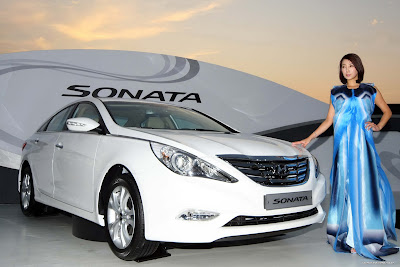The Hyundai Sonata is a mid-size car/full-size car manufactured and marketed globally by Hyundai Motor Company. From the sixth generation onwards, it is known as the i45 in the Australian, Singaporean and New Zealand markets. The car will be known in Western Europe as the i40.
The first Sonata was only sold in a few markets like the Korean domestic one and in Canada as the Stellar II. The vehicle was unveiled in South Korea in November 1985. It was not available in the US because it did not meet the United States emissions standards.
Engine choices include 1.6L, 1.8L or 2.0L I4 (The latter also finding its way into the 1987 and later Stellar, and in MPI form the 1986 Hyundai Grandeur.) The body was based on the Hyundai Stellar.
The Y2 Sonata was part of Hyundai's expansion in North America after the success of the Excel. It was introduced in South Korea on June 1, 1988. It was then introduced in Canada in September 1987 as a 1988 model, and in 1988, as a 1989 model in the United States. The exterior was designed by Giorgetto Giugiaro of ItalDesign. The vehicle received a mid-term facelift in 1991. It replaced the Stellar as Hyundai's large family car. Sonatas were built in Ulsan, Korea, and in Bromont, Quebec.
The Sonata was designed by Hyundai and featured Mitsubishi's engineering, including the platform from the Galant Σ and its 2.4 L 110 hp (82 kW) Sirius I4 engine as used in American-market models. A 3.0 L V6 based on the Mitsubishi 6G72 arrived in 1990. Other markets received 1.8L and 2.0L engines carried over from the first generation, but equipped with MPI,[4] replacing their carbureted counterparts used in the Y1 Sonata. The U.S. model received the 2.0 L engine for the 1992, replacing the original 2.4 L engine.
The Y3 Sonata debuted in 1994, as a 1995 model. The base engine in most markets was a 2.0 L 77 kW (105 PS; 103 hp) Sirius I4, but there was a 3.0 L, 107 kW (145 PS; 143 hp) Mitsubishi V6 option in some markets. This generation continued after the demise of the Bromont, Quebec plant in September 1993. After that, all Sonatas would be built in Korea, until the opening of the Beijing Hyundai plant in December 2002.
The first Sonata was only sold in a few markets like the Korean domestic one and in Canada as the Stellar II. The vehicle was unveiled in South Korea in November 1985. It was not available in the US because it did not meet the United States emissions standards.
Engine choices include 1.6L, 1.8L or 2.0L I4 (The latter also finding its way into the 1987 and later Stellar, and in MPI form the 1986 Hyundai Grandeur.) The body was based on the Hyundai Stellar.
The Y2 Sonata was part of Hyundai's expansion in North America after the success of the Excel. It was introduced in South Korea on June 1, 1988. It was then introduced in Canada in September 1987 as a 1988 model, and in 1988, as a 1989 model in the United States. The exterior was designed by Giorgetto Giugiaro of ItalDesign. The vehicle received a mid-term facelift in 1991. It replaced the Stellar as Hyundai's large family car. Sonatas were built in Ulsan, Korea, and in Bromont, Quebec.
The Sonata was designed by Hyundai and featured Mitsubishi's engineering, including the platform from the Galant Σ and its 2.4 L 110 hp (82 kW) Sirius I4 engine as used in American-market models. A 3.0 L V6 based on the Mitsubishi 6G72 arrived in 1990. Other markets received 1.8L and 2.0L engines carried over from the first generation, but equipped with MPI,[4] replacing their carbureted counterparts used in the Y1 Sonata. The U.S. model received the 2.0 L engine for the 1992, replacing the original 2.4 L engine.
The Y3 Sonata debuted in 1994, as a 1995 model. The base engine in most markets was a 2.0 L 77 kW (105 PS; 103 hp) Sirius I4, but there was a 3.0 L, 107 kW (145 PS; 143 hp) Mitsubishi V6 option in some markets. This generation continued after the demise of the Bromont, Quebec plant in September 1993. After that, all Sonatas would be built in Korea, until the opening of the Beijing Hyundai plant in December 2002.








